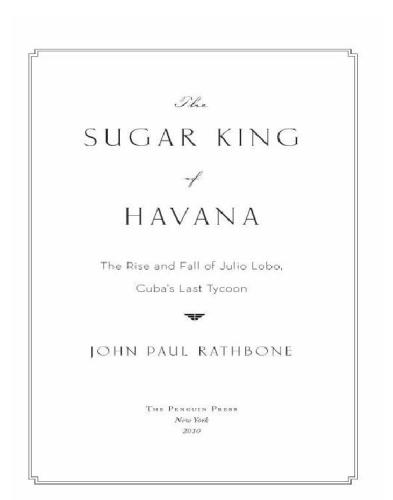
The Sugar King of Havana
The Rise and Fall of Julio Lobo, Cuba's Last Tycoon
کتاب های مرتبط
- اطلاعات
- نقد و بررسی
- دیدگاه کاربران
نقد و بررسی

Starred review from May 17, 2010
The rise and fall of sugar trader Julio Lobo becomes a window into prerevolutionary Cuba, the mechanics of building an economic empire—and the author’s own personal history—in this atmospheric biography by Rathbone, deputy head of the Financial Times’s Lex column and former World Bank economist. Lobo, "Cuba’s richest man and one of the world’s greatest speculators," is an intriguing subject ("friends nicknamed him El Veneno, the poisonous one, for his charm and sibylline tongue"), and Rathbone handles his volte face, from hobnobbing with Bette Davis to the loss of his fortune and death in exile in Spain, with finesse. Ample drama—multiple divorces, audacious hostile takeovers, assassination attempts—is given gravity by Rathbone’s parallels with and personal connections to his subject: his family traveled in Lobo’s social circle in Cuba during the first half of the 20th century. An exceptionally rich portrait not only of an empire and its progenitor but Cuba itself, and the economic legacy of Castro’s revolution, the loss of capital, and the end of Cuba’s "great age of sugar."

June 15, 2010
Wide-ranging life of a Cuban Croesus and a graceful history of the island during the last century.
Julio Lobo wasn't the only man to have earned a fortune in Cuba, as Financial Times contributor Rathbone writes, but he was the only one to have earned an adage: "ser rico como un Julio Lobo—to be as rich as Julio Lobo." Born in 1898, the year of Cuba's independence from Spain, Lobo was the wealthiest man on the island until the Castro Revolution did away with wealthy men. He lived a Citizen Kane–like existence in a palace made of Carrara marble bedded on sand from the Nile River, wooed the most beautiful women and consumed the finest food and drink. Yet, by the author's account, Lobo was quintessentially lonely. Moreover, he was psychologically bound up in a collection that, when it was in one place, was a trove for historians—"the largest holding of Napoleonica outside France, including one of the emperor's back teeth and his death mask." Lobo's fascination with Napoleon spoke to talent in negotiating the intricacies of power on the island, and he flourished in a time of corrupt dictators without being overly corrupt himself. He also generously opened his purse to the then-struggling guerrillas who would come to power in the revolution of 1959. Lobo even acted as a more-or-less informal advisor to Che Guevara when the latter took over as head of Cuba's central bank, a job for which the Argentinean doctor had no credentials. An odd couple, to be sure—but, writes Rathbone, "[b]oth were lucid and deeply rational men," and both took their work very seriously. Things did not end well for either—but that is a story that Rathbone relates with skill as he traces Lobo's far-reaching involvement in almost every aspect of the island's 20th-century history.
Lively, well-written and especially useful to Cuba scholars as they chart the progress of a country in what many are betting to be the last days of Castroism.
(COPYRIGHT (2010) KIRKUS REVIEWS/NIELSEN BUSINESS MEDIA, INC. ALL RIGHTS RESERVED.)

July 1, 2010
Journalist Rathbone details primarily the financial story and secondarily the personal and romantic life of one of Cuba's legendary pre-Castro capitalist speculators, Julio Lobo. Through the life of this Sugar King and astute businessman—and also using details from the Cuban side of his own family—Rathbone aptly illuminates the lives of the prosperous in Cuba in this distinct era. While the sections of the book that deal with Lobo's command of the sugar market are engrossing, those that feature his love affairs are less developed. VERDICTRathbone, as both a child of a Cuban exile and an economist, writes with authority on a less covered aspect of Cuban studies: the life of a capitalist before, during, and after the Castro "revolución" Recommended for readers interested in economics and prerevolutionary Cuba.—Catherine C. McMullen, MLIS, Portland, OR
Copyright 2010 Library Journal, LLC Used with permission.

July 1, 2010
Like Tom Gjelten in Bacardi and the Fight for Cuba (2008), journalist Rathbone evokes pre-Castro Cuba through one of the countrys most successful enterprises, in this case, a sugar empire built by Julio Lobo (18981983). Beginning as a trader in his fathers firm, Lobo became, by the 1930s, a force in the global sugar market. Rathbone recounts Lobos speculative coups en route to direct ownership of cane fields and mills. A visitor to Lobos office, homes, and mills in Cuba, Rathbone contrasts the dilapidation of contemporary Cuba with the look of the prerevolutionary country that he recovers from both Lobos biography and that of his own Cuban-born mother, whose social life tangentially intersected with Lobos world. The present/past technique effectively dilutes the polarizing imperatives of pro- and anti-Castro presumptions and restores a realistic sense of what 1950s Cuba was like, including the guarded optimism with which many upper-crust Cubans such as Lobo initially viewed Castros seizing of power. Rathbones care with social atmosphere lifts his portrayal of Lobo above the usual life-of-a-tycoon and enriches the historical understanding of readers contemplating post-Castro Cuba.(Reprinted with permission of Booklist, copyright 2010, American Library Association.)

























دیدگاه کاربران